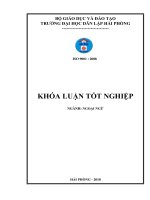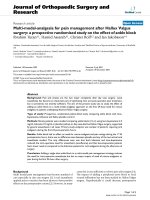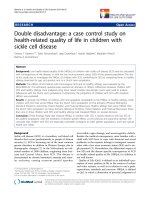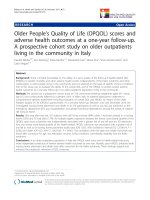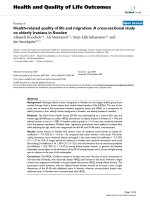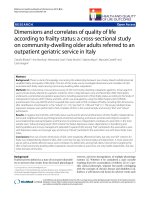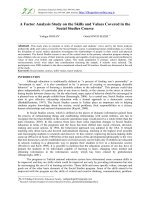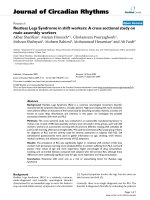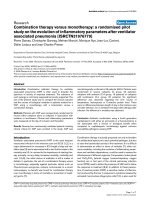A functional grammar study on taylor swifts song lyrics
Bạn đang xem bản rút gọn của tài liệu. Xem và tải ngay bản đầy đủ của tài liệu tại đây (904.5 KB, 101 trang )
MINISTRY OF EDUCATION AND TRAINING
QUY NHON UNIVERSITY
HUỲNH HOÀI THƯƠNG
A FUNCTIONAL GRAMMAR STUDY
ON TAYLOR SWIFT’S SONG LYRICS
Field: English Linguistics
Code: 8220201
Supervisor: Assoc. Prof. Dr. NGUYỄN THỊ THU HIỀN
BỘ GIÁO DỤC VÀ ĐÀO TẠO
TRƯỜNG ĐẠI HỌC QUY NHƠN
HUỲNH HOÀI THƯƠNG
CÁC ĐẶC ĐIỂM NGÔN NGỮ
TRONG LỜI BÀI HÁT CỦA TAYLOR SWIFT
THEO QUAN ĐIỂM NGỮ PHÁP CHỨC NĂNG
Ngành: Ngôn ngữ Anh
Mã số: 8220201
Người hướng dẫn: PGS.TS. NGUYỄN THỊ THU HIỀN
i
STATEMENT OF AUTHORSHIP
I certify that this thesis with the title “A Functional Grammar Study
on Taylor Swift's Song Lyrics” is entirely my own original work. In addition,
I emphasize that this thesis has not been submitted for any purposes in any
materials. Any works of other authors consulted in this thesis are listed in the
reference.
Quy Nhon, 2023
HUỲNH HOÀI THƯƠNG
ii
ACKNOWLEDGEMENTS
The completion of this graduation thesis is the result of not just my
own efforts but also the assistance I have received from various individuals
and organizations, for which I would like to express my sincerest
appreciation.
First and foremost, I am profoundly thankful to my supervisor, Assoc.
Prof. Dr. Nguyen Thi Thu Hien. Her thoughtful guidance, feedback, and
precious advice have been invaluable in shaping this research in spite of her
huge workload. Without her immense knowledge, endless patience, and
constant encouragement during the conducting of the process, this work
would not have been completed.
Secondly, I am deeply grateful to all lecturers from Quy Nhon
University (QNU) for their whole-hearted contribution to sharpening my
academic knowledge during the previous semesters.
Thirdly, I would like to express my warmest thanks to the cooperation
and support of the Department of Postgraduate Training and the Department
of Foreign Languages of QNU.
Last but not least, I would like to take this opportunity to thank my
beloved family and friends, who have always believed in me and given me
the strength to overcome all the troubles I encountered during the fulfillment
of this research.
Quy Nhon, 2023
iii
ABSTRACT
This thesis is carried out with an aim of investigating the three
linguistic metafunctions present in the song lyrics of Taylor Swift, utilizing
the framework of Systemic Functional Grammar developed by Halliday. The
present study focuses on a thorough analysis of the three metafunctions
inherent in language, namely the experiential metafunction, interpersonal
metafunction, and textual metafunction of the language in song lyrics. Both
qualitative and quantitative methods are employed to serve the process of
conducting this research. The study examines a collection of twenty song
lyrics by Taylor Swift, encompassing a range of theme elements. The findings
achieved through the research relate to the three metafunctions that have been
identified in the selected song lyrics by Taylor Swift. To be more precise, the
data indicates that the relational process and material process predominate
over other processes in experiential metafunction. This suggests that the
language employed in Taylor Swift’s song lyrics serves to portray her
experience of the outside world and to illustrate the interconnections among
the characters in the stories. In terms of the interpersonal metafunction, it is
observed that declarative mood is utilized more frequently than imperative
and interrogative moods in the clauses found in Taylor Swift’s song lyrics.
This indicates that song lyrics primarily serve the purpose of conveying
information rather than demanding action or asking for a response from the
audience. Regarding textual metafunction, unmarked topical theme is the
most frequently used theme type among the others. Hopefully, the findings of
this study should help validate the results of previous studies on functional
grammar and provide helpful information for educators and students
interested in learning English.
iv
TABLE OF CONTENTS
STATEMENT OF AUTHORSHIP ................................................................... i
ACKNOWLEDGEMENTS .............................................................................. ii
ABSTRACT ..................................................................................................... iii
TABLE OF CONTENTS ................................................................................. iv
LIST OF ABBREVIATIONS .......................................................................... vi
LIST OF TABLES .......................................................................................... vii
CHAPTER 1: INTRODUCTION.................................................................. 1
1.1. Rationale ................................................................................................ 1
1.2. Aim and Objectives................................................................................ 4
1.2.1. Aim of the Study ............................................................................... 4
1.2.2. Objectives of the Study ..................................................................... 4
1.3. Research Questions ................................................................................ 4
1.4. Significance of the Study ....................................................................... 4
1.5. Scope of the Study ................................................................................. 5
1.6. Organization of the Study ...................................................................... 6
CHAPTER 2: LITERATURE REVIEW...................................................... 7
2.1. An overview of SFG .............................................................................. 7
2.2. The Three Metafunctions ....................................................................... 9
2.2.1. Experiential Meaning ........................................................................ 9
2.2.2. Interpersonal Meaning .................................................................... 16
2.2.3. Textual Meaning ............................................................................. 19
2.3. Previous Related Studies in Song Lyrics ............................................. 23
2.3.1. Discourse Analysis of Song Lyrics................................................. 23
2.3.2. Functional Grammar Analysis of Song Lyrics ............................... 25
CHAPTER 3: RESEARCH METHODOLOGY ....................................... 27
3.1. Research Methods ................................................................................ 27
3.2. Data Collection and Description .......................................................... 27
3.3. Data Analysis ....................................................................................... 27
3.4. Research Procedures ............................................................................ 28
v
3.5. Validity and Reliability ........................................................................ 29
CHAPTER 4: FINDINGS AND DISCUSSION ......................................... 30
4.1. Experiential Metafunction in TSSL ..................................................... 30
4.1.1. Process Types.................................................................................. 32
4.1.2. Circumstances ................................................................................. 48
4.2. Interpersonal Metafunction in TSSL ................................................... 52
4.2.1. Mood System in TSSL.................................................................... 52
4.2.2. Modality System in TSSL............................................................... 57
4.3. Textual Metafunction in TSSL ............................................................ 64
CHAPTER 5: CONCLUSIONS AND IMPLICATIONS ......................... 72
5.1. Conclusions .......................................................................................... 72
5.2. Implications.......................................................................................... 73
5.3. Limitations and Suggestions for Further Researches .......................... 73
REFERENCES .............................................................................................. 75
APPENDICES ............................................................................................... 78
SFG vi
SFL
TSSL LIST OF ABBREVIATIONS
Systemic Functional Grammar
Systemic Functional Linguistics
Taylor Swift's Song Lyrics
vii
LIST OF TABLES
Table 2.1. Types of circumstances (Halliday and Matthiessen, 2004,
p.291) ............................................................................................ 15
Table 2.2. System of types of modality (Halliday and Matthiessen, 2004,
p. 618) ........................................................................................... 19
Table 4.1. The frequency of modality in TSSL .............................................. 58
Table 4.2. Occurrence of modal verbs in TSSL.............................................. 59
Table 4.3. Occurrence of modal adjuncts in TSSL ......................................... 62
Table 4.4. Occurrence of Unmarked and Marked Themes in TSSL .............. 65
Table 4.5. Occurrence of Interpersonal and Textual Themes in TSSL .......... 67
viii
LIST OF FIGURES
Figure 4.1. Frequency of process type in TSSL.............................................. 31
Figure 4.2. Occurrence of Circumstances in TSSL ........................................ 48
Figure 4.3. Mood types in TSSL..................................................................... 53
1
CHAPTER 1: INTRODUCTION
1.1. Rationale
Language, as an integral aspect of human interaction, consistently
attracts scholarly attention owing to its vital role in facilitating
communication, enabling the exchange of ideas, and articulating emotions.
Text, which emerges as an outcome of social interaction, is intrinsically
linked to both spoken and written linguistic forms, encapsulating the
multifaceted nature of human communication and capturing the subtle
distinctions arising in diverse social contexts (Eggins, 2004, p. 2).
Within the domain of linguistic inquiry, Systemic Functional Grammar
(SFG) holds a prominent position, having been developed by distinguished
linguists such as Halliday (1994), Bloor and Bloor (1995), and Eggins (1994).
SFG focuses on examining the grammatical structures embedded in clauses
and explores the various ways in which individuals utilize language in their
social lives. In contrast to traditional grammar, which primarily emphasizes
the rules governing proper language usage, functional grammar encompasses
both spoken and written linguistic expressions and highlights the functional
aspects of language. Consequently, SFG provides a thorough and nuanced
approach for understanding the complexities of language use across different
social situations, which is crucial for a master's thesis aiming to explore
language from a refined and accessible angle.
Hargreaves et al. (2005) argue that songs are a fundamental means of
communication, offering a platform for individuals to express their thoughts,
intentions, and meanings, thereby emphasizing the importance of songs in
promoting human connection and understanding. Song lyrics, created by
composers, seek to entertain listeners, convey messages, and communicate
2
emotions, regardless of whether they are positive or negative, highlighting the
versatile nature of song lyrics and their roles in both artistic expression and
personal communication. By carefully choosing words, song lyrics reveal the
composer's purpose in delivering specific messages, often reflecting the
subject's emotions and attitudes. As such, the analysis of song lyrics can
provide valuable insights into the relationship between language, emotion,
and meaning, making it an essential focus within the context of academic
research into linguistic and communicative properties.
Taylor Alison Swift, known by the name Taylor Swift, is a well-known
American singer-songwriter. She was born on December 13, 1989. In 2010, at
the age of 20, Taylor Swift became the youngest artist in history to win the
Grammy Award for Album of the Year. In 2011, Swift was named Billboard's
Woman of the Year. She has also been named the American Music Awards
Artist of the Year and the Entertainer of the Year by the Country Music
Association and the Academy of Country Music, among many other
accolades. As of this writing, she is also the best-selling musician, with 200
million records sold. Swift has achieved 111 Guinness World Records and
has been honored with the Recording Artist of the Year award on three
occasions by the International Federation of the Phonographic Industry. She
holds the record for being the female touring act that has generated the most
revenue, and she is also the first person in the music industry to amass a net
worth of at least one billion dollars primarily from her music-related earnings.
Swift is a philanthropist advocating for artists' rights and women's
empowerment. She has gotten credit and critical acclaim for her skillful
narrative songwriting, typically inspired by her life experiences.
Numerous approaches utilizing diverse frameworks and perspectives
have been utilized in the study of song lyrics. In recent years, interest in SFG
has increased. Within this area of investigation, an enormous amount of
3
research has been carried out in an attempt to explore the language from the
perspectives of metafunction: the ideational, the interpersonal, and the textual.
Many linguists in the world have made numerous contributions from various
academic aspects. For example, Purwandari, Septyana Atik, et al. (2022)
analyzed the song lyrics of the Energy of Asia Music Album from the
Perspective of SFG. Another research was conducted by Sari et al. (2019),
concentrating on Interpersonal Meaning. The study aimed to describe the
Mood Element which is used in the lyrics of Adele's album 21. Kamaliah
(2021) examined the interpersonal meaning of Mood choices on song lyrics in
the Folklore album of Taylor Swift. Also, Rahayu (2017) conducted a study
on the analysis of Theme in Selected Taylor Swift's Song Lyrics. The analysis
of song lyrics has also been undertaken by several scholars in Vietnam. For
example, Ngan (2018) reviewed attitude resources in English and Vietnamese
love song lyrics. Besides, Nhu (2022) analyzed the metaphor of love in
Taylor Swift’s songs. Trong (2022) discovered the experiential meanings in
song lyrics composed by Chester Bennington. Among diverse research on
linguistic features tested with song lyrics, there seem to be few studies using
SFG to analyze the linguistic features in song lyrics.
Considering the significant role of songs in communication, the diverse
functions of song lyrics, the various research methods employed in studying
song lyrics, and the limited use of SFG in lyric analysis, it is apparent that
further research in this area is necessary. In response to this need, and with
the aim of deepening our understanding of the relationship between language,
meaning, and artistic expression, I have decided to pursue a master's thesis in
this field. By applying SFG to examine the linguistic aspects of Taylor Swift's
lyrics, this research aims to emphasize the importance of this approach in
analyzing song lyrics as a unique form of communication. To achieve these
goals and contribute to the existing body of knowledge in linguistic analysis, I
4
have chosen to conduct a thesis titled “A Functional Grammar Study on
Taylor Swift's Song Lyrics.”
1.2. Aim and Objectives
1.2.1. Aim of the Study
The aim of this thesis is to investigate the linguistic features in Taylor
Swift's song lyrics (TSSL) using SFG developed by Halliday (1994) as an
analytical framework. More specifically, these linguistic features would be
identified from the analysis of experiential, interpersonal, and textual features.
1.2.2. Objectives of the Study
In order to attain the aim of the study, the study is to focus on the
following objectives:
- To identify the experiential features utilized in TSSL from the
perspective of SFG.
- To analyze the interpersonal features employed in TSSL from the
perspective of SFG.
- To explore the textual features used in TSSL from the perspective of
SFG.
1.3. Research Questions
These three questions are answered upon completion of the thesis:
1. What experiential features are expressed in TSSL?
2. What interpersonal features are realized in TSSL?
3. What textual features are presented in TSSL?
1.4. Significance of the Study
The completion of this thesis provides not only theoretical but also
practical benefits. Theoretically, the outcomes of this study are helpful for
future research on three metafunctions within the SFG concept. The study is
also expected to have possible contributions to the body of knowledge of
functional grammar by bringing about insights into three metafunctions in
5
song lyrics. Practically, it serves as an inspiration for English learners and
people interested in song lyrics to study more about this topic. Furthermore,
instructors in linguistics classes might utilize the data in this study as
examples to help English learners comprehend the linguistic characteristics of
the language employed in Taylor Swift's songs.
1.5. Scope of the Study
Indeed, there are a multitude of songs composed by several renowned
artists worldwide. However, for this study, the researcher only examined a
selection of 20 songs authored by Taylor Swift. Taylor Swift's worldwide
recognition and influence indicate the significance of her song lyrics. She has
sold millions of albums, received numerous awards, and amassed a dedicated
fan base across different countries and cultures. The researcher randomly
selected 20 songs penned by Taylor Swift from diverse albums: “Reputation,”
“Lover,” “Folklore,” “Evermore,” “Fearless (Taylor’s Version),” “Red
(Taylor’s Version),” and “Midnights.” The album has achieved extraordinary
achievements, awards and ratings. It is also highly applauded for its
musicality, lyrics, and songwriting style. Taylor Swift won three MTV Video
Music Awards for “Me!” and “You Need to Calm Down” from her seventh
studio album, “Lover,” after receiving a record twelve nominations. At the
63rd Grammy Awards, she became the first woman and fourth artist to win
Album of the Year three times with “Folklore,” her eighth studio album.
“Evermore,” the ninth studio album, was a 64th Grammy Award Album of
the Year nominee. “Midnights,” Taylor Swift's tenth studio album, was
released by Republic Records on October 21, 2022. “Midnights” set global
records in all music mediums. It achieved the Spotify record for the most
single-day streams of an album, Swift's 11th number-one on the Billboard
200, the largest vinyl sales week of the 21st century, the best-selling album of
2022, and the most Billboard Hot 100 top-ten songs in a week.
6
The song lyrics research is carried out based on songs downloaded
from English music websites. Although there are many ways to identify the
linguistic features of a discourse, the study focuses on analyzing three
functional features of SFG. There have been many functional approaches, but
the research is based on Halliday’s framework.
1.6. Organization of the Study
Chapter 1, Introduction, includes the rationale, the aim and objectives,
research questions, the significance of the study, the scope of the study, and
organization.
Chapter 2, Literature Review, reviews the related theory about SFG.
Previous studies from the perspective of the theory and song lyrics are also
introduced.
Chapter 3, Methodology, consists of research method, research
procedures, and the procedure of data collection and data analysis for the
study.
Chapter 4, Findings and discussions, presents the results of the data
analysis to figure out the linguistic features of three metafunctions appearing
in song lyrics.
Chapter 5, Conclusion and implications, summarizes the major
findings, draws conclusions, implications, limitations and puts forward
suggestions for further studies.
7
CHAPTER 2: LITERATURE REVIEW
This chapter provides a clear and engaging overview of the essential
aspects that underlie the theoretical foundation for the research, with a focus
on SFG. Consideration is given to the three crucial metafunctions—
experiential, interpersonal, and textual—which constitute the basis of the
thesis. In addition, a section is dedicated to reviewing prior research related to
the current study, helping to create a thorough understanding of the subject
and placing the research within the broader academic context.
2.1. An overview of SFG
SFG has garnered considerable attention as a significant linguistic
theory, primarily attributed to the pioneering contributions of Halliday (1978,
1994) and subsequent scholars. This framework posits that language fulfills
numerous functions in social communication, effectively establishing
connections between individuals and conveying meaning (Halliday &
Matthiessen, 2014). The ensuing discussion delineates the foundations and
applications of SFG in various linguistic contexts while emphasizing its
capacity to analyze texts and language use in terms of grammar and meanings
(Eggins, 2004, p. 2).
The development of SFG is anchored in the work of British linguist
Michael Halliday, who endeavored to amalgamate the study of language form
with that of language function (Halliday, 1978). Informed by Firth's seminal
work on system-structure theory, Michael Halliday developed SFG in the
early 1960s as an innovative approach to linguistics that both builds upon and
transcends its theoretical antecedents. This development signifies not merely
a chronological extension but an epistemological advancement, as Halliday
integrated Firth's foundational concepts into a more comprehensive and
8
functional linguistic framework. Contrasting traditional grammar, Halliday's
approach accentuates the various purposes of language use rather than merely
cataloging structural features (Bloor & Bloor, 2004). SFG primarily focuses
on the grammar choices associated with meanings, referring to the purpose of
the speakers or writers and the concrete forms of language (Matthiessen &
Halliday, 2014, p. 3).
According to Halliday and Matthiessen (2014, p. 10), SFG presents
language as a semiotic system that is socially embedded, which sets it apart
from conventional models that primarily focus on syntax. The theory places
significant emphasis on the notion of "choice," asserting that linguistic
choices are shaped by the social environment and are evident in the range of
systematic options accessible to individuals who use language (Halliday &
Matthiessen, 2014, p. 23, 60). SFG utilizes a hierarchical framework that
effectively separates and links various linguistic strata, including semantics,
lexicogrammar, and phonology, in order to conduct a detailed analysis
(Halliday & Matthiessen, 2014, p. 29). Furthermore, the incorporation of the
concept of "register" enables the analysis of linguistic characteristics that are
linked to particular social contexts (Halliday & Matthiessen, 2014, p. 30). The
SFG provides a comprehensive framework for comprehending language as a
dynamic system that is influenced by social processes.
The three metafunctions at the core of SFG are experiential,
interpersonal, and textual (Halliday, 1994). These metafunctions exemplify
the various manners in which language fulfills its communicative functions
within social contexts. SFG determines how the speaker or writer creates
meanings in spoken or written texts, with clauses having three broad
functions called language metafunctions (Halliday & Matthiessen, 2014).
These language metafunctions can be broken down into many linguistic
realizations when constructing spoken or written texts.
9
SFG has been utilized as a theoretical framework in a myriad of
linguistic studies, spanning from multimodal discourse analysis (Kress &
van Leeuwen, 2001) to cross-linguistic research (Butler, 2003) and
pedagogical applications in language teaching (Derewianka, 2011). The
versatility of this framework lies in its capacity to unveil the intricate
connections between language, meaning, and social context, rendering it a
valuable instrument for understanding the complexities of human
communication. Consequently, SFG is concerned with how language is
functionally used as a text in context, providing resources in the form of
wording to express its speech function and pointing out the language use
and structure within different contexts (Matthiessen & Halliday, 2014, p.
3).
2.2. The Three Metafunctions
2.2.1. Experiential Meaning
Experiential meaning, is an important feature of ideational
metafunction, enables writers to depict external realities, representing and
interpreting patterns of experience in a coherent manner. The ideational
metafunction operates on the semantic plane and consists of two components:
experiential meanings and logical meanings. According to Halliday (1994),
the experiential characterizes clauses as representation and concentrates on
ideas and content. It also demonstrates how individuals actively interpret
reality by categorizing the things and events that come into their awareness.
In contrast, the logical emphasizes the symbolic representation of reality and
experience through language and focuses on the relationship between ideas,
or as Halliday puts it, "systems which set up logical-semantic relationships
between one clausal unit and another" (Halliday, 1994). This study, however,
will focus solely on experiential meaning. As posited by Martin et al. (1997),
the transitivity system pertains to the experiential metafunction within the
10
clause, allowing individuals to conceptualize the world.
Halliday (1994, p. 36) characterizes the experiential meaning in the
transitivity system as a resource for "construing a model of experience,"
encompassing three aspects: the process, the participants in the process, and
the circumstances associated with the process. Process types, which constitute
the primary aspect, consist of six subtypes. Among these, material, mental,
and relational processes are particularly salient, while behavioral, verbal, and
existential processes comprise the remaining categories. The transitivity
system, therefore, plays a crucial role in capturing experiential meaning by
delineating the configuration of possible participants, processes, and
circumstances.
2.1.1.1. Material Processes
In the context of experiential meaning within SFG, material process
plays a pivotal role in representing actions or events, both concrete and
abstract, that involve various participants. As delineated by Halliday (1994),
material process entails the occurrence of an action or event in which an
object 'does' something, potentially affecting another object. This process
captures the essence of 'doing' or 'happening' in the construction of
experiential meaning.
The material process encompasses several participants, each
contributing to the overall structure and meaning of the action or event. The
Actor, as the primary participant, carries out the material action, while the
Goal represents the entity impacted by the action. Additionally, the Range
serves to specify the scope or extent of the action, and the Beneficiary denotes
the participant who benefits from the action (Halliday, 1994).
Chia bought some curry yesterday.
Actor Process: material
Goal circumstance
(Bloor & Bloor, 2004, p.109)
